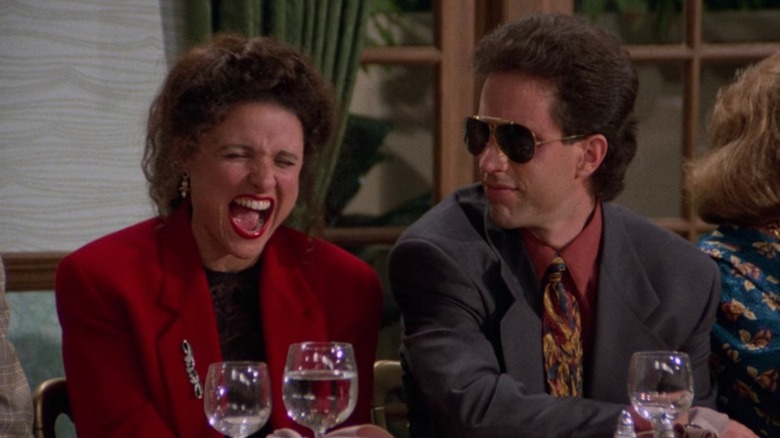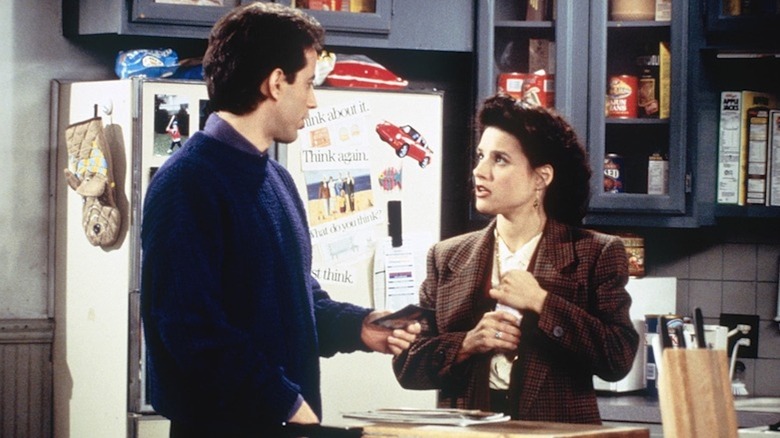The Seinfeld Storyline That NBC Executives Demanded (And Eventually Got)
Regardless of genre, television series lean heavily on the will-they-or-won't-they relationship between two main characters to generate real-life and online buzz. You know how it works: two seemingly mismatched characters (e.g. the "Cheers" duo of Ted Danson's caddish Sam Malone and Shelley Long's intellectual Diane Chambers) discover, often to their own disgust, that they're hot for this person they should despise to the marrow of their bones, and it's only a matter of time before their spark-shooting flirtation leads to a full-on sexual conflagration. We've seen it more recently with Tony DiNozzo (Michael Weatherly) and Ziva David (Cote de Pablo) on "NCIS" (which spawned the forthcoming "NCIS: Tony and Ziva"), and we'll see it over and over again because the hoary formula works.
This is another reason why "Seinfeld" is one of the most brilliant shows in television history. There was no will-they-or-won't-they because the only "they" conceivable within the realm of the show was Jerry (Jerry Seinfeld) and Elaine (Julia Louis-Dreyfus) — and they'd already done it. When the series began, they were friendly exes, and the show's writers weren't interested in creating a will-they-again dynamic because the series had other, unconventional narrative ideas. So at no point were viewers clamoring for the pair to hop back in the sack.
Television executives, however, are a different breed. They only want what's good for ratings, and when they saw the critically acclaimed "Seinfeld" mired in the back end of the Nielsen ratings' top 50 during its second season, they pressured series co-creator Larry David into getting Jerry and Elaine back together. They succeeded, but not in the way they wanted.
Jerry and Elaine had the most unromantic fling in television history
When NBC executive Warren Littlefield began leaning on David to make Jerry and Elaine a classic sitcom couple, the headstrong writer flatly refused. He loved the duo's unusually fun and not-too-flirty platonic relationship, and didn't want to sacrifice what made the show special — even though viewers were slow to discover "Seinfeld." (It didn't truly take off until its fourth season.) But Littlefield was insistent, so David finally relented. He was determined, however, to lose this battle with a little creative dignity.
"The Deal" aired late in the series' abbreviated second season. The episode kicks off with Jerry and Elaine watching television and accidentally running across a softcore pornography channel. This prompts the friends to reveal to each other that they haven't had sex in a while. They decide they could help relieve each other of some coital frustration, so they strike a deal that is tailored to allow for a non-friendship-ending sexual relationship (which was actually inspired by a real-life agreement David once worked out with a female friend).
While shooting the episode, executives were concerned that the negotiation between Jerry and Elaine was too impersonal. To them, it played like they were hammering out a business arrangement — which is precisely how David wanted it to play. On the episode's DVD commentary track, David recalled, "I remember everybody saying, 'There's no heat, there's no heat,' and I said, 'That's the point, there's not supposed to be any.'"
David intended "The Deal" to be the season finale, but it got pushed forward, which made the ensuing episodes feel a little strange because Jerry and Elaine were carrying on as if "The Deal" had never happened. By the time season 3 rolled around, David felt confident he'd satisfied the executives' desires, and turned the Jerry-Elaine relationship platonic again. Fortunately, the topic was never revisited, because one of the most endearing aspects of "Seinfeld" is the way Jerry and Elaine candidly discuss their romantic missteps with one another.

